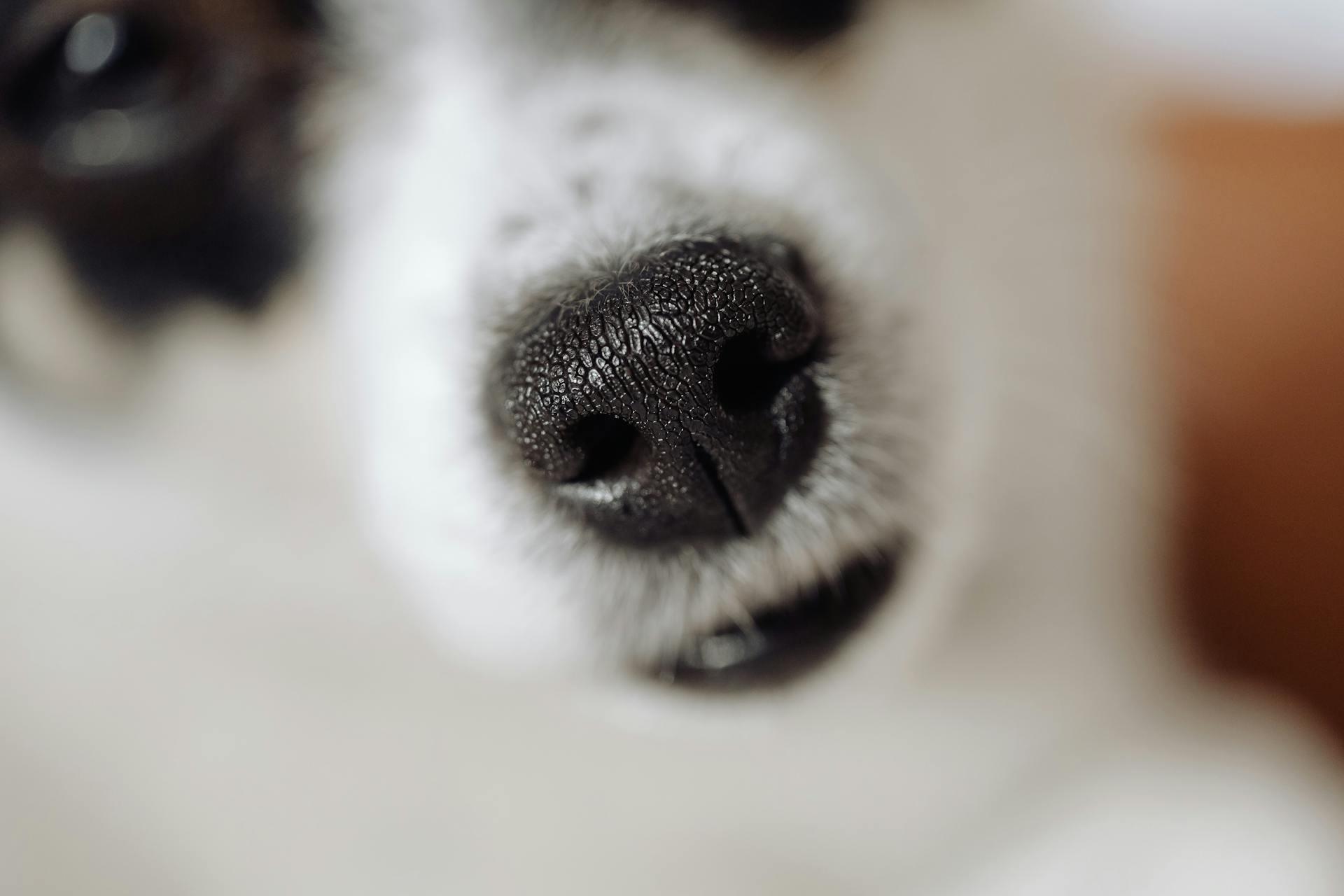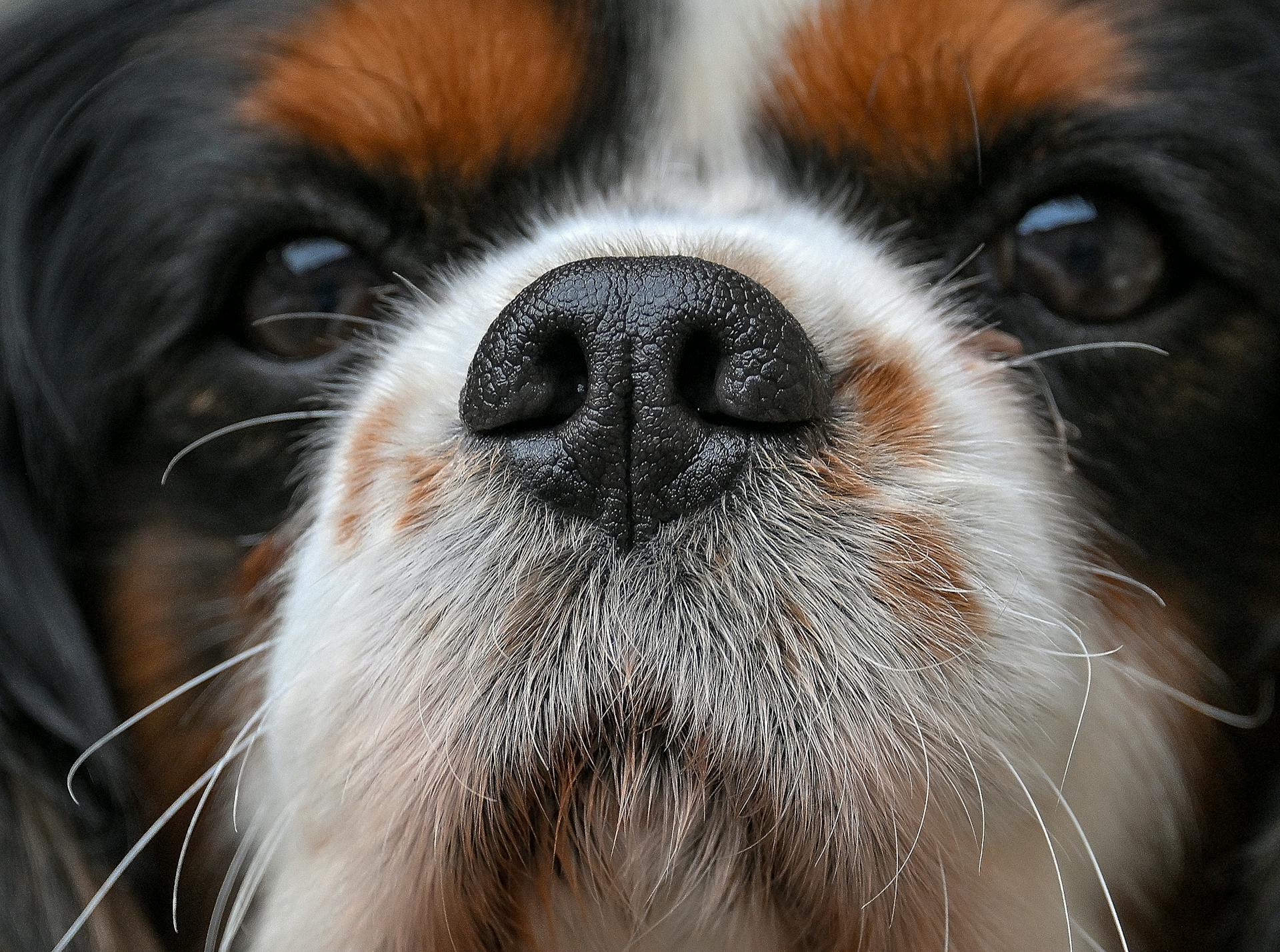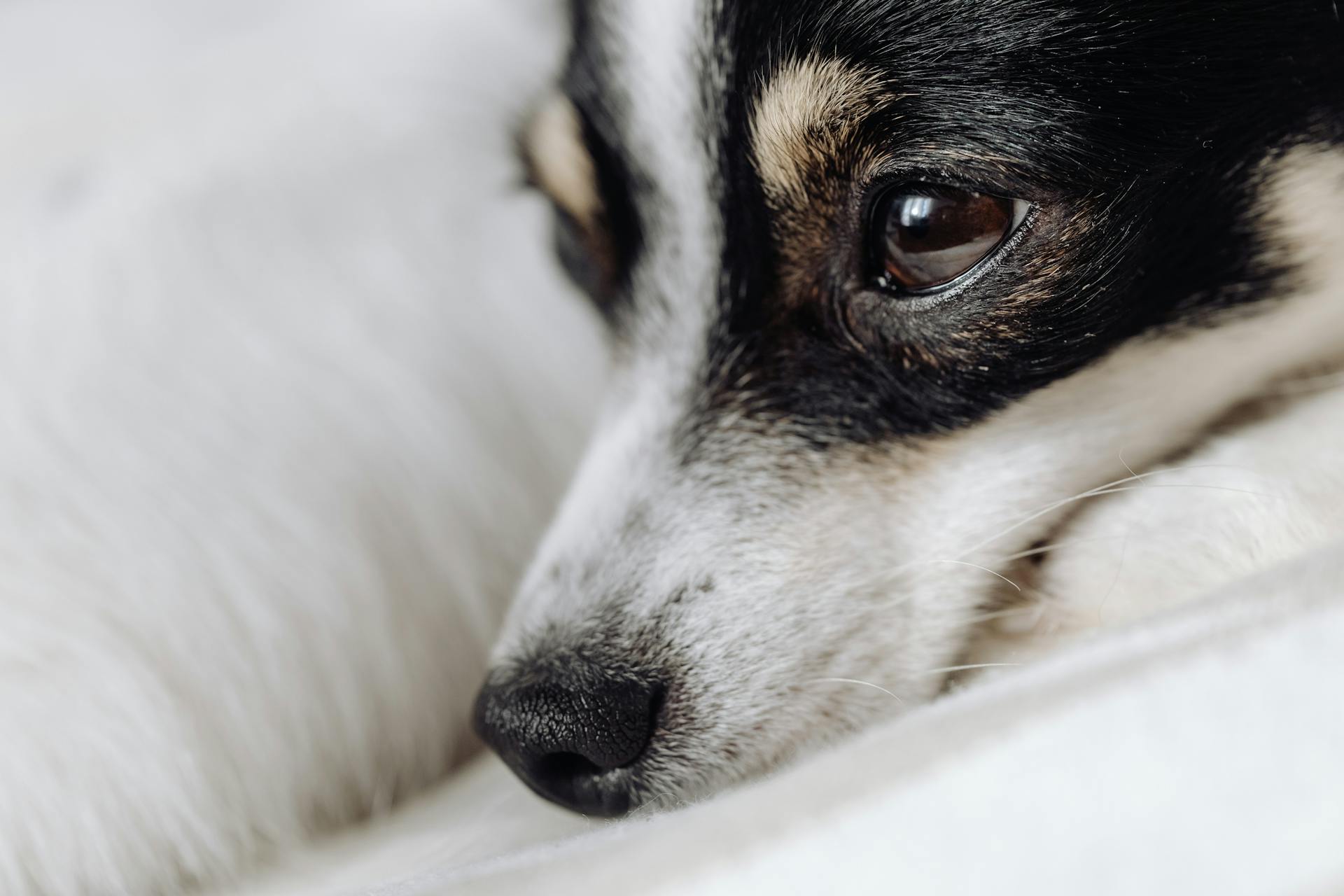
A rough dog nose can be a concerning issue for many pet owners. Dry skin and inflammation are common causes of a rough dog nose.
Some breeds, such as Bulldogs and Pugs, are more prone to a rough dog nose due to their flat face structure. This can lead to breathing difficulties and other health issues.
A rough dog nose can be caused by allergies, with pollen, dust, and other environmental allergens being common culprits. Regular grooming can help alleviate symptoms.
In severe cases, a rough dog nose can be a sign of an underlying health issue, such as autoimmune disorders or skin infections.
If this caught your attention, see: Bull Terrier Skin Issues
Causes of Rough Dog Nose
Dry and cracked dog noses can be a real issue, and understanding what causes them is key to addressing the problem. Environmental Factors such as extreme cold or hot temperatures can dry out a dog's nose.
Dehydration is another common cause, just like in humans, dogs can get dehydrated, leading to dry and flaky noses. Excessive licking can strip away natural oils, making the nose dry and cracked.
Explore further: Dog Paws Rough Cracked
Allergies to pollen, dust, or certain foods can trigger nasal irritation, causing a dog to rub their nose and make it dry. Infections like bacterial or fungal infections can wreak havoc on a dog's nose, causing crustiness and peeling.
Here are some severe medical factors that can cause a dry, crusty nose:
- Discoid lupus erythematosus (DLE), an inflammatory skin disease that affects the mouth, nose, and eyes.
- Distemper, a viral disease that affects puppies who are not vaccinated.
- Idiopathic Nasodigital Hyperkeratosis, a skin disease that causes overproduction of keratin on the nose and foot pads.
- Hereditary nasal parakeratosis (HNPK), a genetic disease common in Labrador Retrievers.
Identifying the Problem
Your dog's crusty nose might be a seasonal issue, so pay attention to whether it happens more in the summer or winter months.
Dry air can cause a crusty nose, especially during the winter when the air is drier.
Notice if your dog's snout becomes crusty after being outdoors in cold weather.
Nasal hyperkeratosis is another possible cause of a crusty nose.
Explore further: Can a Bug Bite Cause a Lump on a Dog
Treating Crusty Skin
Unfortunately, there isn't a cure for nasal hyperkeratosis in dogs, so you'll need to treat the condition for the remainder of your puppy's life.
Treating a dry and crusty nose requires a veterinarian's examination to diagnose the underlying cause. Your vet can recommend appropriate treatment options, which may include moisturizing ointments or lotions.
Soaking your dog's skin in warm water regularly can help reduce discomfort from nasal hyperkeratosis. This will keep their nose hydrated and reduce painful cracking.
Some natural remedies have promising results, but be cautious and consult with your veterinarian before trying any new treatments.
If your dog's nose remains dry and crusty or other symptoms develop, it's essential to seek veterinary care. In many cases, a dry and crusty nose will resolve on its own, especially if it's due to environmental factors like sunburn or exposure to dry air.
Here are some common causes of dry and cracked dog noses:
- Environmental Factors: Exposure to harsh weather conditions, such as extreme cold or hot temperatures, can dry out a dog's nose.
- Dehydration: Just like humans, dogs can get dehydrated, leading to dry and flaky noses as a result.
- Allergies: Allergies to pollen, dust, or certain foods can trigger nasal irritation, causing a dog to rub their nose and make it dry.
- Excessive Licking: Dogs that compulsively lick their noses can strip away natural oils, leading to dryness and cracking.
- Infections: Bacterial or fungal infections can wreak havoc on a dog's nose, causing symptoms like crustiness and peeling.
Natural Alternatives to Treatment
There are several natural and safe ingredients you can use to keep your dog's nose nice and moist.
Coconut oil is a great alternative to harsh chemicals for soothing a rough dog nose.
It's also a good idea to use a humidifier in your home to add moisture to the air, which can help to soften a crusty dog nose.
Olive oil can be applied directly to the nose to help lock in moisture and soothe dry skin.
Aloe vera gel is another natural remedy that can help to calm and hydrate a dry dog nose.
Health and Wellness
A dry or rough dog nose can be a concerning issue for any pet owner. If your dog's nose is dry, it doesn't always mean they're sick.
However, some common causes of a dry nose in dogs include dehydration, which can be easily fixed by giving them some water and a way to cool down. Additionally, dogs will commonly develop dry noses after sleeping, which is completely normal.
Here are some unhealthy signs to look out for in your dog's nose:
- Dryness or rough texture
- Cracks or fissures
- Discoloration
- Bleeding
- Excessive licking
- Sneezing or congestion
- Bumps, sores, or crusts
- Runny or mucus-filled nose
If you suspect your dog is struggling with allergies, which can also cause a dry nose, take them to see the vet. Your veterinarian can provide them with the necessary prescription medication to help control allergic reactions.
What Does 'A's Mean?
A dry and crusty nose in dogs is a common occurrence. It can be caused by several factors, often harmless, but it's always best to get your pup checked out by a vet to rule out any underlying health issues.

A dry nose is not necessarily a sign of illness in dogs. It's a good idea to keep an eye on your dog's nose and consult a vet if you notice any unusual changes or if your dog shows other signs of illness.
Your dog's nose being crusty and dry can be a normal occurrence, but it's always better to be safe than sorry. Get your pup checked out by a vet to rule out any underlying health issues.
A different take: Vets Dog Treats
Symptoms of Unhealthiness
A healthy dog nose is a great indicator of overall health, and it's essential to recognize the signs of unhealthiness. A dry nose can be a normal occurrence, especially after sleeping.
Dogs with dry noses may also be dehydrated, but giving them water can usually fix the issue. Unless your dog is showing severe signs of dehydration, it's nothing to worry about.
A dry and crusty nose can be a common occurrence, but it's always best to get your pup checked out by a vet to rule out any underlying health issues. This is because a dry nose can be caused by several factors, often harmless.

Here are some unhealthy signs to look out for in a dog's nose:
- Dryness or rough texture
- Cracks or fissures
- Discoloration
- Bleeding
- Excessive licking
- Sneezing or congestion
- Bumps, sores, or crusts
- Runny or mucus-filled nose
If you've noticed any of these symptoms, it's time to take your dog to the vet for a health check. They can diagnose whatever's causing the crusty nose and recommend the best treatment possible.
Allergies
Dogs can have allergic reactions, just like humans, and a dry nose is often one of the symptoms. A veterinarian can provide prescription medication to help control allergic reactions.
Many dog breeds are allergic to various things, including food, pollen, and certain chemicals. Allergies can cause a dog's nose to become dry and itchy, leading to excessive scratching and a dry, crusty nose.
To prevent further irritation, it's essential to identify the allergen and eliminate it from your dog's environment.
For another approach, see: Breeds of Dogs in a Dog's Purpose
Specific Conditions
Some serious health conditions can cause a dry, crusty nose in dogs.
Discoid lupus erythematosus (DLE) is an inflammatory skin disease that affects the nose, mouth, and eyes, leading to loss of pigment and sores.
Distemper, a viral disease, can also cause a dry nose, especially in unvaccinated puppies.
Other conditions, like Idiopathic Nasodigital Hyperkeratosis, can cause overproduction of keratin on the nose and foot pads.
A genetic disease like Hereditary nasal parakeratosis (HNPK), which affects Labrador Retrievers, can cause a dog's nose to turn dry.
Intriguing read: Von Willebrand Disease in Doberman Pinschers
Severe Medical Factors
Your dog's dry, crusty nose can be a sign of some serious health issues. Discoid lupus erythematosus (DLE) is an inflammatory skin disease that causes loss of pigment and sores around the mouth, nose, and eyes.
Distemper is a viral disease that primarily affects unvaccinated puppies. It's crucial to ensure your puppy is up-to-date on their vaccinations to prevent this condition.
Idiopathic Nasodigital Hyperkeratosis is a skin disease that causes excessive keratin production on the nose and foot pads. This condition can lead to a dry, crusty nose.
Hereditary nasal parakeratosis (HNPK) is a genetic disease commonly found in Labrador Retrievers, which can cause a dog's nose to turn dry.
Check this out: What Causes Diabetes in Dogs
Nasal Hyperkeratosis
Nasal Hyperkeratosis is a condition where keratin builds up around a dog's nose, causing it to become dry and crusty. This can lead to discomfort and hinder a dog's sense of smell.
Not all dogs are affected equally, with some breeds being more prone to nasal hyperkeratosis than others. These include Mastiffs, Boxers, Bulldogs, Pugs, French Bulldogs, Poodles, and German Shepherds.
A dry and crusty nose can also be a sign of more serious illnesses, such as Discoid lupus erythematosus (DLE), Distemper, and Idiopathic Nasodigital Hyperkeratosis. It's essential to rule out these conditions before treating nasal hyperkeratosis.
There is no cure for nasal hyperkeratosis, but regular soaking of a dog's skin in warm water can help reduce discomfort and keep the nose hydrated. This can be a simple and effective way to manage the condition.
Here are some breeds that are commonly affected by nasal hyperkeratosis:
Infections
Infections can be serious business, especially if left untreated.
If your dog's dry, crusty nose is accompanied by nasal seepage like mucus, it could be a sign of an infection.
Bacterial or fungal infections can cause the nose to become dry and scaly.
If left untreated, the infection can spread to other parts of the body.
Expand your knowledge: Dog Lump on Side of Ribs
Frequently Asked Questions
What does hyperkeratosis look like on a dog's nose?
A dog's nose with nasal hyperkeratosis appears dry, crusty, and bumpy, with excess tissue growth on the nasal planum, especially on the top of the nose. This condition causes visible ridges and bumps on the non-haired areas of the nose.
Sources
- https://www.frenchiemob.com.au/blogs/news/caring-for-your-frenchie-part-1-dry-nose-peeling
- https://berthoudanimalhospital.com/dogs-nose-is-dry/
- https://www.innovetpet.com/blogs/diseases/crusty-dog-nose
- https://www.fitbark.com/blog/dry-dog-nose-woes-why-your-dogs-nose-is-dry-and-crusty
- https://squishface.com/blogs/blog/common-dog-nose-problems
Featured Images: pexels.com


